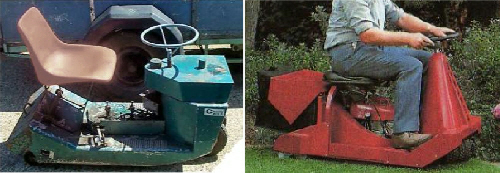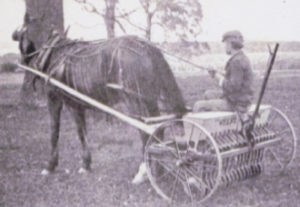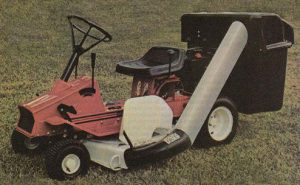Fifty Years Ago…..
January 9, 2020 in Articles, Machinery

The mower of the future, but from the past.
Horticultural machinery hasn’t, on the whole, faired much better; mowers, tillers and rotavators etc are much the same as they’ve always been, with just minor tweaks and amendments to make them better to operate. But where could we have been if madcap designers had pushed through their ideas and the general public had clambered aboard? Take the 1960’s prototype mowing machine as pictured above. This glass-domed futuristic machine encased the operator in an air-conditioned capsule from where they could mow the lawn, apply fertilizer, or according to adverts even go to the shops. In our health-conscious era the ideal solution for mowing the lawn is to use a pedestrian mower and get some exercise and fresh air rather than ride around getting sunstroke in a goldfish bowl – but a push mower wouldn’t be as much fun as that 1960’s Jetson inspired machine would it?

Remploy Mowmaster, a very clever and advanced version of the ‘mower tied to stick’ principle. The beginning of the robot lawnmower, perhaps?
If you’d like to see how far robot mowers have progressed, and witness their potential for the domestic garden, have a look at this Cub Cadet mower on Youtube, it is brilliant. https://youtu.be/kPibtLfYEWQ?t=48
For now though, lets head back in time 50 years and see what the clever people designing horticultural equipment were busying themselves with. More importantly what has happened to these machines introduced in 1970? For some of them there is no trace left.

Sisis Auto-Cutter and Turfman

John Allen & Sons 5-26 ride-on mower
In 1970 John Allen also introduced three models of 19″ push rotary mowers called the ‘Export’ (2.5hp Aspera 2-stroke engine), ‘Special’ (4-stroke, 3hp engine) and ‘Professional’ (2-stroke Aspera Longlife 4hp engine). The Professional model had four “Inox” swinging steel blades for mowing the grass and all models had optional side-mounted grass collection kits available for £3. I have yet to come across these three mowers.
During the 1960’s and 70’s several horticultural machinery manufacturers had their technical boffins in deep thought and serious contemplation, probably over cups of tea and newly introduced Mr Kipling’s cakes; they were designing, creating and producing battery powered machinery. As we hit the 1980’s most gave up on battery-powered stuff and the items that remained being produced were mostly novelties such as shrub trimmers and low-powered items. 1970 was when the brilliantly named Ladybird Appliances LTD of Reading, Berkshire, introduced a new dual purpose lawn edger called the Mowtrim. It was powered by two 6 volt Lucas long life batteries providing power to a 12 volt D.C. SIBA motor. It’s main use was as a lawn edger where it’d do a splendid job, or clutching at straws it was a “rotary mower with a 7 inch width of cut” for those with small lawns or immense patience. Price: £18 17s.

Toro Teesmaster which was distributed by Flymo Ltd
The machine pictured was newly on sale for 1970. It’s claim to fame being that it was believed to be the first power-driven gang mower that could also collect grass with it’s attached grassboxes. The grassboxes are fitted at the front of the front two cutter reels and the back grassbox is fitted to the rear of that cutter. Price: £640.

Masport 18″ Premier mower with Johnson Iron Horse engine
Other items of interest in 1970 include a new version of the 18″ Hayterette mower by Hayter Ltd, Bishop’s Stortford. It had a new deck design incorporating a wide rear flap to give even distribution of grass clippings. Marketing says it was available with a 4-stroke Briggs and Stratton with 147cc (£41), or the Professional models with J.L.O 2-stroke engine or a 205cc Briggs and Stratton (both £52).
One item that I cannot find at present is the Wolf Car Mower. This was a new machine introduced by Wolf Tools for Garden and Lawn Ltd of Ross-on-Wye, Hertfordshire. It is a ride-on, 26″ rotary grass cutter and could have basic attachments like a grass collector, sweeper, roller, and interestingly could be fitted with trailed cylinder gang mowers, This 5hp Briggs and Stratton machine had two forward and one reverse gears. The Wolf Car Mower was of a flexible design which helped it’s ability on uneven ground. I thought this might have had something to do with the Wolf Garden Kart which is like a go-cart, but this was much later than the Wolf Car Mower and had a smaller cut of 22″.
The question nowadays is how will the future designers develop machines in the coming decade? Will we have a multitude of powerful, efficient and long lasting battery machines by 2030.
Or… perhaps decades from now the petrol machines of yesterday may be sought after, and considered as well built machines capable of a days work with ease? We may already be living in the future by using machines of the past…but just not aware of it!







 ….The reason is that Webb make several subliminal references to expense which may not go down too well with the person who controls the purse strings. Webbs advice is to “Go for the best you can afford” and “Webb recommended prices allow your dealer to provide….guidance, instruction, preparation and service requirements” i.e this ain’t gonna be cheap. In the picture on the right we see the Webb mower being invited to afternoon tea and admired by it’s new owners – it’s not just a new mower but a piece of one-upmanship over the entire neighbourhood and their new-fangled Flymos. The Webb is something to aspire to.
….The reason is that Webb make several subliminal references to expense which may not go down too well with the person who controls the purse strings. Webbs advice is to “Go for the best you can afford” and “Webb recommended prices allow your dealer to provide….guidance, instruction, preparation and service requirements” i.e this ain’t gonna be cheap. In the picture on the right we see the Webb mower being invited to afternoon tea and admired by it’s new owners – it’s not just a new mower but a piece of one-upmanship over the entire neighbourhood and their new-fangled Flymos. The Webb is something to aspire to.  Let us visit some old technology which is now new technology that hasn’t progressed much from the old technology and get ourselves a battery mower to cut down on the use of petrol. The largest 18″ deluxe model which is the left mower in the picture was £132.00 in 1973, approx 30% more than the petrol version. The smallest model was a 12″ cut and priced £54.95 (prices inc tax).
Let us visit some old technology which is now new technology that hasn’t progressed much from the old technology and get ourselves a battery mower to cut down on the use of petrol. The largest 18″ deluxe model which is the left mower in the picture was £132.00 in 1973, approx 30% more than the petrol version. The smallest model was a 12″ cut and priced £54.95 (prices inc tax). The next models are the petrol powered stuff, this is where one can be accused of wanting a mower purely because it has an engine. As can be seen in the image the gentleman has been accompanied to the dealership to ensure money isn’t squandered on unnecessary and frivolous purchases, honestly, as if anyone would buy stuff on a whim to hoard in the shed. Besides, there’s a really scary receptionist lurking in the background to keep things in order.
The next models are the petrol powered stuff, this is where one can be accused of wanting a mower purely because it has an engine. As can be seen in the image the gentleman has been accompanied to the dealership to ensure money isn’t squandered on unnecessary and frivolous purchases, honestly, as if anyone would buy stuff on a whim to hoard in the shed. Besides, there’s a really scary receptionist lurking in the background to keep things in order. 
 For utter devilment our gentleman in the dealership image could be forced by his female companion to have a hand-push mower, that’d teach him to look out of the kitchen window and daydream for a petrol powered machine instead of getting on with doing the washing-up at home. The push mower range consisted of the 10″ Whippet, 12″ Wasp and 12″ Witch. Respectively priced at £17.54, £18.64 and £25.24 inc tax.
For utter devilment our gentleman in the dealership image could be forced by his female companion to have a hand-push mower, that’d teach him to look out of the kitchen window and daydream for a petrol powered machine instead of getting on with doing the washing-up at home. The push mower range consisted of the 10″ Whippet, 12″ Wasp and 12″ Witch. Respectively priced at £17.54, £18.64 and £25.24 inc tax.  Once the lawn is cut then it’s time to do the edges and Webb come to the rescue with a battery-operated lawn edger. This talented machine has a 6 volt battery that can trim for about 45 minutes – about 1200 yards of lawn edges. It has a 7″ blade that revolves at 5000 rpm giving about 10,000 cuts per minute. Apparently it can trim lawn edges better than they have ever been trimmed before – I think some professionally trained groundsman might have disagreed with that statement but they probably agree that it was a lot easier than using long-handled shears.
Once the lawn is cut then it’s time to do the edges and Webb come to the rescue with a battery-operated lawn edger. This talented machine has a 6 volt battery that can trim for about 45 minutes – about 1200 yards of lawn edges. It has a 7″ blade that revolves at 5000 rpm giving about 10,000 cuts per minute. Apparently it can trim lawn edges better than they have ever been trimmed before – I think some professionally trained groundsman might have disagreed with that statement but they probably agree that it was a lot easier than using long-handled shears. 




















 Then, a year after I started looking for this mower I find a magazine advert (image right) with dealers name and address of Hyett Adams in Gloucestershire, which confirms they were sold in the UK and it wasn’t just some magazine hear-say to fill their editorial pages.
Then, a year after I started looking for this mower I find a magazine advert (image right) with dealers name and address of Hyett Adams in Gloucestershire, which confirms they were sold in the UK and it wasn’t just some magazine hear-say to fill their editorial pages.





